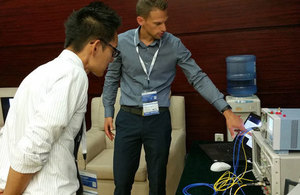HiLight Semiconductor: new technology to increase broadband speed
Company exhibits at trade shows in China and the US to launch an integrated circuit innovation that could help solve the problem of over-stretched broadband.

Demonstrating the integrated circuit developed by HiLight Semiconductor at a trade show in Shenzhen, China.
Global broadband networks are under increasing strain due to bandwidth-intensive applications such as cloud computing, video streaming and the Internet of Things. Experts fear this could lead to demand for data outpacing supply.
According to the EU Fibre to the Home Council, “fast broadband infrastructure is now a determining factor in ensuring the economic fortunes of cities and regions”. Although modern fibre optic cable can provide almost unlimited bandwidth, the current interface technology is expensive and restricts speeds to 1 or 2.5Gbps, which is then often shared with at least 20 users.
HiLight Semiconductor has developed a new patented integrated circuit (IC) that provides an innovative solution to the problem – an approach that is simple yet flexible. HiLight provides software to control the IC but systems providers can change it if needed. HiLight believes the new IC offers the lowest operating power, at low cost, allowing speeds of up to 10Gbps, both upstream and downstream.
The company demonstrated the solution at 2 trade shows recently – in Shenzhen, China, and in San Diego, California.
Next-generation services is one of the challenges of the Industrial Strategy Challenge Fund – part of the government’s Industrial Strategy. Part of the challenge asks companies like HiLight Semiconductor to apply for funding to ensure UK service sectors are at the forefront of developing and using innovation.
Find out more about the next-generation services challenge.
Innovating ahead of market demand
So far, HiLight Semiconductor has exported more than 50 million integrated circuits worldwide. Independent analysts, Ovum, expects the 10G ‘fibre to the home’ market to add over 50 million more units each year within the next 5 years.
Gary Steele, Executive Chairman of HiLight Semiconductor, explains his company’s approach:
Communications infrastructure can be a relatively slow-moving industry, but it has a very long lifetime too. We took our time to look at analyst reports and speak to customers and worked out ways we could speed up our customers’ production lines, for example, by maximising the number of components integrated on our IC. The telecoms industry wants low-power, robust designs that work totally reliably over the extremes of outside temperatures and over many years of continuous operation.
When we started out, very few people knew about the inner workings of broadband, but now you see optical fibre in TV adverts and people are more aware of the Internet of Things. They certainly know about 4G and perhaps 5G phones. Our integrated circuits help provide the backbones that can support all this data, video, cloud computing and all the new services that seem to arrive as soon as more - and lower cost - capacity becomes available.
A fast-growing business
HiLight Semiconductor recently came 6th in the Syndicateroom’s Top 100 of Britain’s fastest-growing businesses. In the last year, the company has created more than 15 new high-level engineering jobs and the total number of employees will soon reach 60.